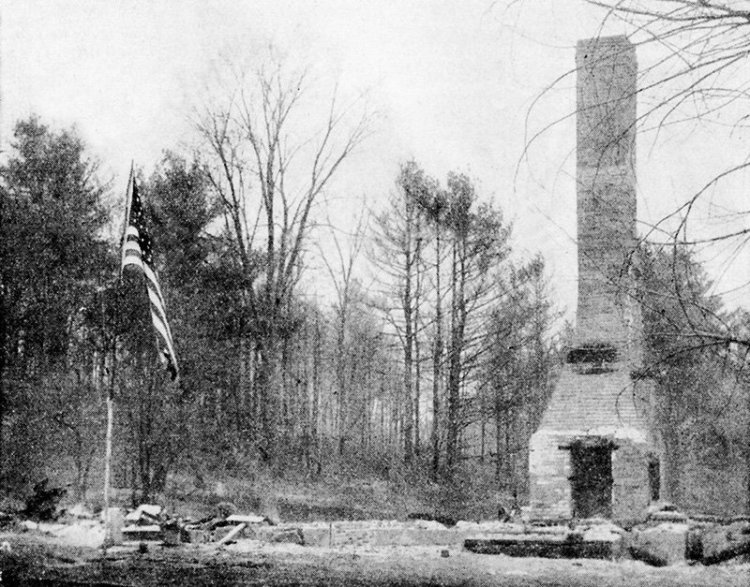On Oct. 27, 1947, the Portland Press Herald created a minor mystery in an interesting sidelight to the disastrous forest fire that swept York County. On that Sunday a reporter-photographer team, “browsing” through the charcoal forest seeking aftermath pictures, stumbled upon a brave and unusual scene, eloquent in its silence.
An American flag, fluttering in a smoke-laden breeze over the ashes of a farmer’s buildings, was all that moved on a remote country road in Dayton.
The photograph, published the next day, was one of the most impressive of the hundreds upon which the sorry history of that conflagration was written. Its caption, “Our Flag Was Still There,” gave the special significance to the bravery and pluck of all of the burned-out inhabitants who turned to when the smoke had scarce drifted away, rebuilding, many on the same foundations.
Few knew what prompted the homeless farmer to fly the flag that day on his ravished hillside. Some guessed, many wondered – but all were impressed.
Today the Sunday Telegram, thanks to a bright-eyed high school girl and her mother, unravels that minor mystery of the forest fires of ’47. The solution came about quite by accident.
A junior at Kennebunk High School, her English instructor had asked the class to write themes on the picture that impressed them the most. The picture of the flag was the one she selected. She never did get ranked on it, in fact, her only reward when it was returned with a semi-satisfactory “Ummmpphh.”
That, however, was not enough for a proud mother who, after reading the unraveling of the mystery of the flag, decided others might be interested in the solution.
Here it is, exactly as written by 16-year-old Beverly Abbott of Goodwin’s Mills – who, as it turned out, had every good reason for writing the story:
The Story Of A Flag
By Beverly Abbott
This picture was taken in Dayton, Maine, in the year 1947, right after the great, destructive forest fire. It tells the typical story of a farmer, left homeless by this fire.
If the flag could talk, I’m sure it would say, “Hello, chimney. What happened here? Where are the people? Where are the house and barn? Where are the cats, and my friend, the dog?”
The great chimney stands guard over the well-loved grounds, now charred and blackened. Beneath it are the ruins of the house which so long supported it. Behind it stand the trees, gaunt and ghostlike, stripped of their beautiful green.
The flag is the one spot of color in this desolate area. In the paragraph under the picture it says: “What prompted this action no one knew – ” But, I do.
It started just about the time the war started. A white-haired man, himself a Spanish War veteran, had raised it on the day that his oldest son and his only daughter enlisted in the service of their Country. He is in the air corps, and she in the Wacs.
The man would take his flag each morning at sunrise and go outside. He would take off his hat and lay it on the ground beside him. His big, black curly dog, Toby, would stand at attention, his paws on the man’s arm, while the flag went up. The man’s wife would watch from her kitchen window. He never missed a day.
In January, four years ago, the old gentleman died.
But, his morning ritual didn’t.
His son had returned from the service, and he, for whom that flag had been raised every morning, now raised it for the old man who had done the same for him.
Each morning Toby would go out and stand by the flagpole. He seemed disappointed that it was the son and not his old master. His eyes always seemed to say: “Where is my master? Why doesn’t he come along, too?”
When the fire came on October 23, the old man’s wife and her son nearly lost their lives trying to coax the faithful Toby to follow them to safety. Toby refused to come. He died that day in the old barn because he would not leave his master’s flag shrine.
I believe that the master and his dog are together now.
You wonder how I wrote this story? Maybe you think I made it up – but, I didn’t.
You see, the elderly couple are my grandparents, and their son, who continued his father’s ritual, even on the morning of the greatest disaster that had ever befallen him, was my uncle.
Send questions/comments to the editors.



Success. Please wait for the page to reload. If the page does not reload within 5 seconds, please refresh the page.
Enter your email and password to access comments.
Hi, to comment on stories you must . This profile is in addition to your subscription and website login.
Already have a commenting profile? .
Invalid username/password.
Please check your email to confirm and complete your registration.
Only subscribers are eligible to post comments. Please subscribe or login first for digital access. Here’s why.
Use the form below to reset your password. When you've submitted your account email, we will send an email with a reset code.